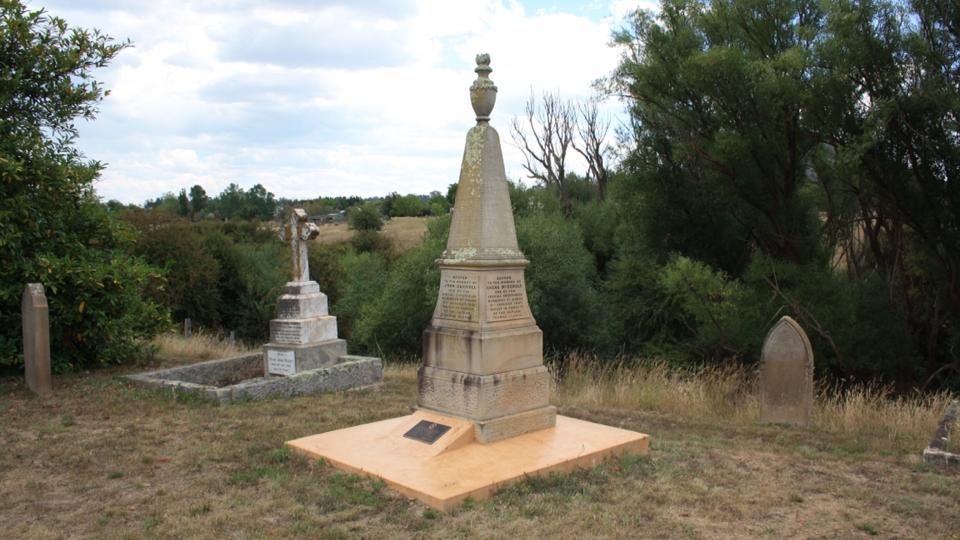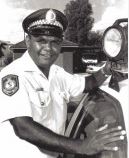John CARROLL, Patrick KENNAGH, Eneas McDONNELL, John PHEGAN
John CARROLL
Patrick KENNAGH
Eneas McDONNELL
John PHEGAN
New South Wales Police Force
Regd. # ????
Rank: ALL were Special Constables
Stations: ?
Service: From ? ? ? to 9 January 1867
Awards: ?
Born: see below
Died on: Wednesday 9 January 1867
Event location: Braidwood
Cause: Shot – Murdered
Age: see below
Funeral date: ?
Funeral location: ?
Buried at: Braidwood Cemetery
[alert_green] John CARROLL, Patrick KENNAGH, Eneas McDONNELL & John PHEGAN are mentioned on the Police Wall of Remembrance[/alert_green] *NEED MORE INFO


John Carroll (a senior warder at the Darlinghurst Gaol) was the leader of a group of four men sworn in as special constables to search for and capture the Clarke Gang of bushrangers. The patrol consisted of Carroll, Patrick Kennagh, Eneas McDonnell and John Phegan. They were well-armed and in January, 1867 had for some time been posing as surveyors in the Braidwood area in an attempt to discover the whereabouts of the bushrangers. On the afternoon of 9 January the four men were walking through an area of very dense bush on Jinden Station, having left their horses behind on that day for some reason, when they were ambushed.
Witnesses apparently twice heard shooting in the area at that time but did not investigate until the following day. In a clearing in the bush McDonnell and Phegan were found, shot to death, and about 800 metres away Carroll and Kennagh were found, also shot to death. Carroll was found lying on his back with a neatly folded handkerchief on his chest with a one-pound note pinned to it. A large sum of money he was carrying in his pocket had not been touched. The wounds suffered by Carroll and Kennagh suggest that not only were they murdered, but that they were actually “executed”. It is generally thought (and also often disputed) that their attackers were members of the Clarke Gang, however this has never been proved.
The Sydney Morning Herald of 12 January, 1867 informed its readers of the following.
BRAIDWOOD – MURDER OF THE SPECIAL CONSTABLES.
Friday: The four special constables – Carroll, MacDonald, Fagan, and Kennagh – sent here to capture Clarke’s gang, were on a visit to a station at Jinden, when they heard that Clarke would be at a place two miles distant from there, the constables went on foot with the intention of endeavouring to capture him, and, it is presumed, were met by a lawless mob and shot dead. It is said that Carroll’s legs had been broken, and his feet turned to his head. The mournful news reached Braidwood last night, and caused universal indignation, and cast a gloom over the entire population. Mr. Griffin and Superintendent Orridge are now holding an inquiry.
Like Carroll, Kennagh and McDonnell were prison warders (McDonnell was also an ex-policeman), while Phegan had been chosen for the search because, as a former associate of the Clarkes, he knew the Braidwood area well. They had been authorised by Colonial Secretary Henry Parkes to undertake a “secret expedition for the capture of the bushranger Thomas Clarke and his associates.” They had been promised wages, reward money (if successful) and significant positions in the Public Service for their endeavours. This situation, of course, was not popular at the time with substantive New South Wales police officers. A monument was later erected in the memory of these men at the Braidwood Cemetery (and inexplicably, McDonnell is referred to as Eneas ‘McDonald’).
These murders represent the highest number of police ever killed in a single incident of this type in Australian history. It is only surpassed by the spearing of patrols of Native Mounted Police in Queensland in the 1860’s. (Ned Kelly killed three Victorian police officers in a single incident at Stringybark Creek in 1878).
Special Constable McDonnell was born in 1817,
Special Constable Carroll in 1829,
Special Constable Phegan in 1837, and
Special Constable Kennagh in 1841.
[divider_dotted]
Clarence and Richmond Examiner & New England Advertiser ( NSW ) Tuesday 12 February 1867 page 3 of 8
Meetings of sympathy with the families of the special constables recently murdered continue to be held, and much indignation is expressed at the rottenness and inefficiency of our expensive military police force. A commission, with a great preponderance of officialism in it, has been appointed, to inquire into the circumstances of the late murders of the special constables, and the state of the Braidwood district. The public have little confidence in the fitness of the commissioners.
http://trove.nla.gov.au/ndp/del/article/63665154
[divider_dotted]
http://trove.nla.gov.au/newspaper/article/112710985
[divider_dotted]
Police and Bushranger descendants tour bushranger sites in district
Braidwood was overflowing with people during the weekend from visitors who had come to town for all sorts of events and celebrations.
The Police and Bushrangers Descendants who travelled from all over NSW and some from QLD came to enjoy the company of like-minded people and to learn more about the local Braidwood bushrangers and the policeman who were involved in their capture in April 1867.
The group was lucky to have many distinguished historians and authors who facilitated as commentators, guest speakers and experts. This was a well-run event.
The group would like to thank Paul and Annette Briggs and family who spent many long hours scheduling and organising the experience. As a result, all of the participants enjoyed their time in the Braidwood District. Paul Briggs is a descendant of Lionel Pottinger, one of the Special Police sent after the Clarkes.
The group gathered at the Braidwood Services Club on Friday night for dinner followed by a briefing on the weekend and guest speakers from within the group before their early start the next morning.
About 80 people, including local guests, gathered at the Garan Vale Woolshed at 8.15am on Saturday morning ready to depart for their day tour of the significant sites of the Connell and Clarke bushrangers in the Ballallaba, Krawarree, Jinden and Kain areas of the district.
The first interesting site was the Clarke residence on the Cooma Rd adjacent to Brick Kiln Creek where Jack and Mary Clarke (parents of Tom and John Clarke) lived. Peter Smith and Paul Briggs spoke and recited information about this site. Along the way Paul Hart provided information about several curious sites along the road, including Mrs Appleby’s store and house, the Willis homestead, Bendora and bridle tracks including the Rugby Track.
The group viewed the Nithsdale homestead and the surrounding property where the oldest of the Clarke children were born, during the 1840’s. This was also the location of the local Ballallaba police Station. Along the road, the tour mangers pointed out the Coles, the Church, the school, the Berriman and Connells family home sites.
The areas and locations of the Griffin brothers were also pointed out. These three brothers had substantial involvement in the Bushranging episode during the 1860s.
The site of a well known and notorious landmark, ‘Michael O’Connell’s Traveller’s Home Hotel,’ opposite Jim O’Connell’s house was pointed out. A few stories were told and a visit to the Gundillion cemetery provided a few photo opportunities of Michael O’Connell’s gravestone.
Morning tea was abundantly provided by the good hosts of the Deua Tin Huts. A few more stories were exchanged and were appreciated by all.
The group was eager to travel to Khan Yunis to locate the site of Berry’s Hut where the Clarke bushrangers were finally taken by a small but dedicated group of troopers in 1867.
A substantial luncheon was provided by the Gundillion Progress ladies at the local hall. After a delicious lunch, the group travelled to Jinden to visit the property of Janette and John Hindmarsh where the temporary burial site and the site of the killing of the four unfortunate Special constables was pointed out to the large group.
On travelling back to Braidwood the tour travelled along the Jerrabatgulla Road visiting the house site of Michael Connell senior and ‘Gilston‘, the family home of the Hart family. This is where Charlotte Hart, the wife of Tom Clarke grew up and lived. The group was bailed up by a couple of bushrangers who travelled on the bus to Braidwood ensuring that all travellers behaved themselves.
On arriving in Braidwood a quick stop at the local Braidwood Cemetery allowed the group to visit the final resting place of the Four Specials. The large memorial that was built to remember them was regarded with much interest.
On Saturday night a marvellous dinner and singalong was had at the Garan Vale Woolshed. Peter Smith led the vocals on several songs from the bushranging era to demonstrate how the community supported and even sympathised with the bushrangers during that chapter of Australia’s history, like this verse from the Kelly’s Byrne and Hart “..As high above the mountains so beautiful and grand, Our young Australian heroes in bold defiance stand, In bold defiance stand, my boys, the heroes of today, So let us stand together boys, and shout again, “Hurray!””
The weekend was topped off on Sunday with an interesting tour of the local Historical Museum and a tour of the Bedervale Homestead. Many thanks to Jill Clarke for her notes from the tour.
[divider_dotted]
A bloody ambush. Clarkes to be retried. pdf
http://www.bwdmag.com.au/BWD_11/%20BWD11_2223.pdf
[divider_dotted]


By coincidence there were two warders named John Carroll at Darlinghurst Gaol at the time of the Braidwood murders. The other was born in County Cork, Ireland, in 1828. He joined the prison service in the 1850s and retired on 31 December 1892 with the rank of Deputy Governor.